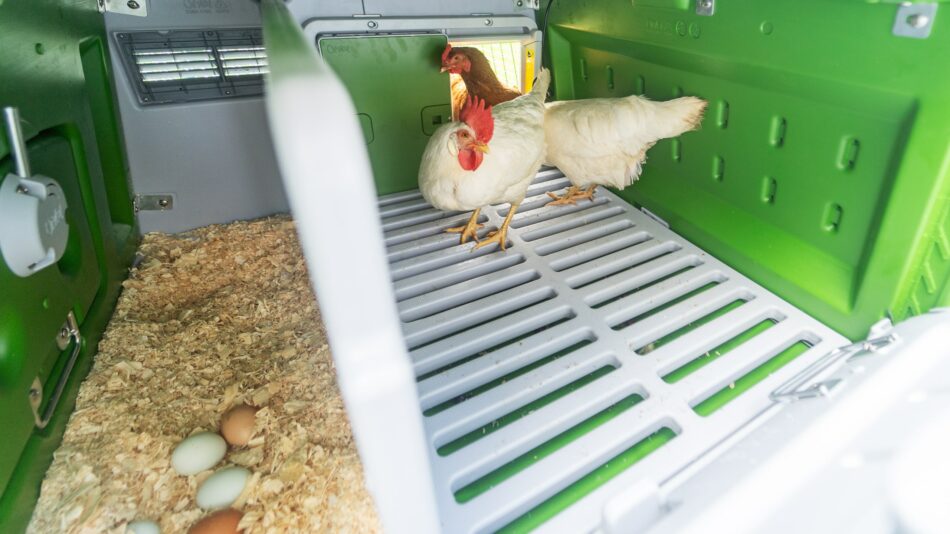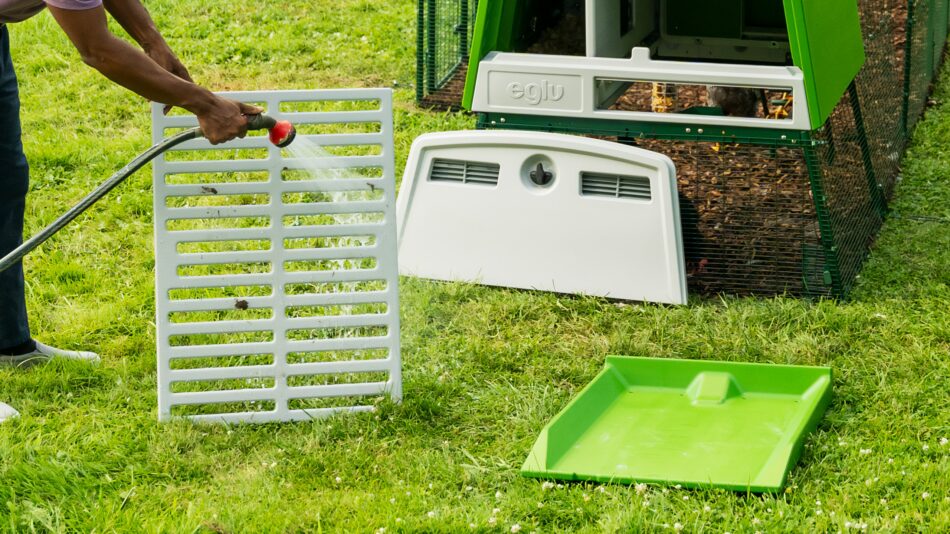Chicken roosts 101
Chicken roosts are an essential part of a flock’s setup. They’re simple in their concept, but chicken roosts can prove difficult to perfect in their construction and placement. Omlet has taken the guesswork out of the perfect chicken roost, and we’ve incorporated them in all of our chicken coops. Read on to see how to help your hens make the most of roosting time for their well-deserved beauty rest.
What is a chicken roost?
You can think of your chickens’ roost as their bed — and like a mattress, a roost can make or break a good night’s rest. Chickens will spend anywhere from 8-12 hours roosting, depending on the amount of daylight. When the sun starts to set, your hens will instinctively head to their cosy chicken coop.
Setting up the perfect roost for your chickens
The perfect place for chickens to go to roost is:
- Set up above ground level
- Separate from egg-laying areas
- Shielded from the elements
- Safe from chicken predators
Chicken roosts should be constructed of easy-to-clean materials, and should be comfortable for your hens’ feet. Traditionally, roosts have been either round or rectangular bars that are small enough around for chickens’ feet to grasp. But, since chickens squat down to cover their feet when they roost, these bars have them performing a balancing act all night long. A much better alternative is a flat, textured surface for them to get comfortable on.
Creating an ideal roosting area is a vital part of how to take care of your chickens. This secluded, comfortable area should make your hens feel safe and protected all night long. Quality sleep contributes to your flock’s overall health and well-being, making their roosting area a fundamental element of their setup.
Why do chickens roost?
A “roost” is both a verb and a noun: chickens roost at night in their roosts. Roosts are where birds congregate in order to sleep, and their biological clock tells them when to roost. Some birds roost on the ground, but many species of birds, both wild and domestic, seek roosting places that are above ground level. Chickens are part of the elevated-roosting group of birds.
Protection from predators
Being elevated while sleeping makes hens feel safer from chicken predators and the weather. In the wild, many birds roost in trees that offer a canopy of shelter from the elements. Similarly, your chickens will seek a place that is both elevated and shielded from the wind, rain, and snow.
Pecking order at night
When night begins to fall, your hens will begin to head in to roost in their coop. If you observe the order in which they turn in, it’s common for hens at the top of the chicken pecking order to claim their spot in the roost first, and the rest will follow suit down to the lowest-ranking hen. In an established flock, the top-ranking hens will make sure every flock member has a place in the roost.
Keeping your hens safe whilst roosting
By the time the last hen has turned in for the night, it will be past sunset. This is when predators are most active, which is why hens instinctively roost before nightfall. To add an additional layer of protection, an automatic chicken coop door can be installed on your hens’ house to make sure everyone is tucked in safely after dark.
Difference between chicken perches & roosts
Not to be confused with a roosting area, chicken perches are bars set up inside of your flock’s run to give them space to climb and exercise. Many hens enjoy being above ground level at various times throughout the day to observe their surroundings. Hens will flap, fly, or hop their way up to their perches, which help to strengthen and stretch their wings.
Chicken perches like the PoleTree Customisable Chicken Perch or the Freestanding Chicken Perch are designed for play and enrichment, or maybe the occasional afternoon nap in the sun – but not for overnight sleep. Roosting overnight on a chicken perch in the run leaves your hens exposed to the elements and at higher risk of encountering predators.
Common chicken roost problems
Many chicken keepers mean well when they set up their flock’s roosting area, but most homemade constructions fall flat when it comes to creating restful roosts. Oftentimes homemade roosting bars or racks:
- Are hard to clean
- Invite mites
- Weaken over time
Any poorly placed, wobbly, or unlevel chicken roosts will be deemed unfit for sleep by your flock. You may also notice older hens avoiding roosts that are too high, as their joints can’t support them when they dismount each morning. Heavier hens may also have trouble flying up to roosts that are too high.
Uncomfortable, unsafe, or cramped roosts can lead to a chicken not going to their coop at night. Instead, your hens may find their roost in nesting boxes or on perches out in their run. This behaviour can quickly become frustrating and dangerous, and should be addressed as soon as possible.
How much roosting space per chicken?
Another potential problem with homemade roosts is inadequate spacing. Sometimes there’s just not enough room for the last hen or two to find a comfortable spot in the roost at night. On the flip side, if there’s too much space, hens may feel vulnerable. This is a problem particularly in the winter months, as hens will huddle together for warmth overnight.
Different chicken breeds have varying space requirements, but as a general rule, you should aim to provide approximately 8-12 inches of space on the roost per hen. Omlet’s large chicken coop has a roosting area that can accommodate up to 10 hens comfortably.
Best chicken roosting bar material
There are different types of roosting bars and racks. We’ve outlined the most common materials, and the pros and cons of each.
Wooden roosts
Wood is the most traditional material for constructing chicken roosts. It’s affordable, easy for chickens to grab onto, and readily available. However, wood has its fair share of disadvantages as well.
Cons:
- Absorbs moisture and odours, allowing bacteria to breed
- Harbour mites and other insects
- Can splinter off into your hens’ feet
- Warps, rots, and deteriorates over time
- Hard to clean
Pros:
- Affordable
- Readily available
- Cut and placed easily
For all of its popularity, wooden roosts are not the most practical solution. There is a lot of maintenance and upkeep involved in wooden roosts, and most chicken keepers would do well to avoid them.
Metal roosts
At a cursory glance, metal roosts may look appealing. They’re easy to clean, long-lasting, and don’t require much upkeep. But even with these advantages, the biggest drawbacks involve your beloved hens.
Cons:
- Slippery and hard for hens’ feet to grasp
- Easily affected by temperature – they can be burning hot or freezing cold to the touch
- Expensive
- Difficult to adjust or cut to size
Pros:
- Long-lasting
- Easy to clean
As you can see, metal roosting bars and racks can be very dangerous for your hens. In cold weather, chickens can actually become frozen to metal roosts, and in hot weather, the metal can burn your hens’ feet. Their longevity might be appealing, but it isn’t worth the risk to your hens. There’s an even better, long-lasting solution.
Plastic roosts
Plastic has the best of both worlds: easy to maintain and safe for your hens. Here are the pros and cons of plastic:
Pros:
- Easy to clean with a pressure washer or sponge
- Doesn’t absorb moisture
- Not hospitable to mites and insects
- Easy for your hens’ feet to grasp
- Is not easily influenced by the temperature
- Long-lasting and does not require routine maintenance
While plastic roosts may be hard to make yourself, Omlet has perfected the plastic roosting rack that is included in all of our chicken coops. The ergonomic design fits perfectly in the coop with a slightly textured surface to give your hens’ feet purchase on the smooth material. And, being made of heavy-duty plastic, your Omlet setup will be the only one you’ll ever need to buy.
Cons:
- Difficult to cut to size
- Not readily available (apart from an Eglu chicken coop)
Chicken roost ideas
The ideal chicken roost will be:
- 3-4 feet off of the ground
- Made of an easy-to-clean, comfortable material
- Large enough to accommodate your flock, but small enough to make them comfortable
- Separated from their nesting boxes
This particular setup may prove to be difficult to design within an existing coop. Plastic is extremely durable, but difficult to cut with common tools – not to mention hard to come by. So what’s a chicken keeper to do when pursuing the perfect chicken roost? Thankfully, Omlet has the solution to this conundrum.
Creating the ideal chicken roost with Omlet
The Eglu Cube has a divider that can be closed to prevent hens from roosting in the nesting area, and has designated doors for both the roosting area and nest box. Additionally, the Eglu Cube’s roosting area has:
- A roosting rack constructed of heavy-duty plastic with a textured overlay to help your hens grip the surface
- Small openings for droppings to pass through to the tray below, which also offers small footholds for your chickens
- A large, flat area perfect for your hens to hunker down for the night
The fully enclosed Eglu Cube makes it a formidable fortress for your flock during their most vulnerable times. With the dual-insulated walls and ample ventilation, your chickens will never be more comfortable.
The other two chicken coops from Omlet are:
- The Eglu Go
- The Eglu Go Up
Both of these coops are for smaller flocks of 2-6 hens, and include the same style of roosting rack as the Eglu Cube. In addition to a plastic chicken roost, both coops also feature:
- Dual insulated walls and ample ventilation
- The ability to add on wheels and handles to convert them into mobile chicken coops
- Easy-to-clean interior components that can all be pressure washed or wiped down
All of our chicken coops help foster your flock’s natural behaviours and habits, including a comfortable and secure roosting routine.
Chicken care with Omlet
From roostime to playtime, give your chickens the best when you choose Omlet for all of your flock-raising needs. All of our products have been rigorously tested by both our team of experts and through daily experience from our customers. Our dynamic chicken tractors and unique toys like the Chicken Swing are sure to be a delight to both flocks and their raisers.
This entry was posted in Chickens


